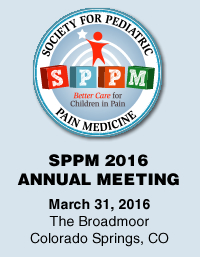2015 ASA Annual Meeting Review
Pediatric Pain Medicine Abstracts at the 2015 ASA Annual Meeting
 Madhankumar Sathyamoorthy, MBBS, MS
Madhankumar Sathyamoorthy, MBBS, MS
Children's Hospital of Mississippi
Mark E. Thompson, MD, FAAP
Women & Children’s Hospital Buffalo
University at Buffalo
Pediatric pain abstracts presented at this year’s ASA meeting in San Diego, addressed diverse clinical problems. Some of the topics included, the efficacy of regional blocks for supracondylar fractures and ACL repairs, the cost benefit of using IV acetaminophen for tonsillectomy, use of IV methadone, potential problem of opioid over-prescription and association of pain in PACU to chronic persistent postsurgical pain.
In the only international abstract, Mosettii et al. from Italy, offered an interim analysis of a prospective cohort of children receiving combined general and regional anesthesia for outpatient general, urologic, and orthopedic procedures. Prevalence of persistent pain in their study population is 3.1% at one month and 0.4-0.8% at months three and six. They found a strong correlation between elevated pain scores in the PACU and persistent postoperative pain. 70% of patients with persistent pain experienced pain scores higher than 4/10 in the recovery room. We look forward to further reports from this study to find out if and what role might be played by regional anesthesia in decreasing acute pain in PACU and in persistent chronic pain.
Huang et al., from Texas Children’s Hospital completed a retrospective case-control evaluation of IV methadone for scoliosis surgery. Non-mu effects of methadone make it a very useful perioperative analgesic, particularly for long painful surgeries. A single pre-incision dose of IV methadone between 0.1-0.2 mg/kg was used. The anesthetic management was not standardized and methadone not re-dosed. They reported a significant reduction in use of morphine equivalents during the anesthetic but not in post-operative period (POD1-POD3). Nausea and vomiting, sedation, respiratory depression, and pruritus were unchanged between the intervention and control groups. Prospective randomized studies are needed in future to identify the optimum dose of IV methadone and whether redosing of methadone would offer additional benefit in optimal analgesia in postoperative period.
The cost of Intravenous (IV) acetaminophen has increased in recent times. Kaveh Aslani et al., from Beaumont Hospital in Michigan, conducted a small randomized controlled trial (40 patients) comparing oral acetaminophen given 90 minutes preoperatively to intravenous acetaminophen. No intraoperative opioid was administered. They found no significant difference between the groups in total post-operative opioid use, time to first rescue medication, FLACC score and parental satisfaction. The authors point out that the significant cost difference between IV and oral acetaminophen warrant larger clinical trial to confirm their finding in this study.
Hsu et al., from John’s Hopkins investigated the problem of over-prescription of opioid by the physicians to treat moderate to severe pain among children. 292 patients out of 433 patients completed a scripted validated telephone survey at the end of two days and/or two weeks. They reported significant amounts of remaining opioid medication, most of them reported not being appropriately educated about proper disposal of their leftover medication and very few actually disposed them.
Most of the parents were satisfied with the pain control. Moreover, many of these patients had adolescent siblings living in their homes. Is the cause of overzealous prescribing a lack of provider education? Or is it regulatory barriers that prevent access to frequent refills of smaller amounts? We at least now have evidence that community prescription drug abuse is not just a problem of easy access to "grandma's drugs", but that pediatric providers may also be overprescribing, and that a lack of an appropriate disposal plan for unused prescription medication may be a part of the problem as well.
In a randomized study of supracondylar fractures undergoing pinning, Chris Glover et al., reported superior analgesia with ultrasound guided supraclavicular block compared to intravenous opioids. Participation was good with 64 patients out of 115 returning diaries with pain scores. The block group had less pain and less emergence delirium scores in the recovery room. The peak pain scores remained lower among the block group over 48 hours (the primary outcome measure). In contrast, pain spiked at 12 hours in the block group as the block wore off. The drawback of limited duration of single shot blocks and importance of educating parents about starting oral pain meds before the block wears off is highlighted in this study.
A retrospective review by Leanne Foster et al., from National Children's Hospital sheds some light on combining regional blocks for ACL repair in children. They conclude that femoral with/without sciatic blocks are helpful in reducing perioperative use of morphine. They also found that combining femoral block with sciatic block is superior to just femoral block. It will be interesting to study if the regional block benefits extend beyond the immediate post-operative period such as improving the functional recovery and reducing persistent postoperative pain.
In a second abstract from Beaumont Hospital, Kaveh Aslani et al., found that there is no difference in efficacy between pre-incision transversus abdominis plane (TAP) block and field infiltration by surgeon for post op pain management following hydrocelectomy. Block and field infiltration used similar 0.5 ml/kg volume of 0.5% Ropivacaine. Total fentanyl dose, parental satisfaction, and FLACC pain scores were similar amongst the two groups. Whether the study was sufficiently powered to rule out a significant difference between the groups was not clear.

